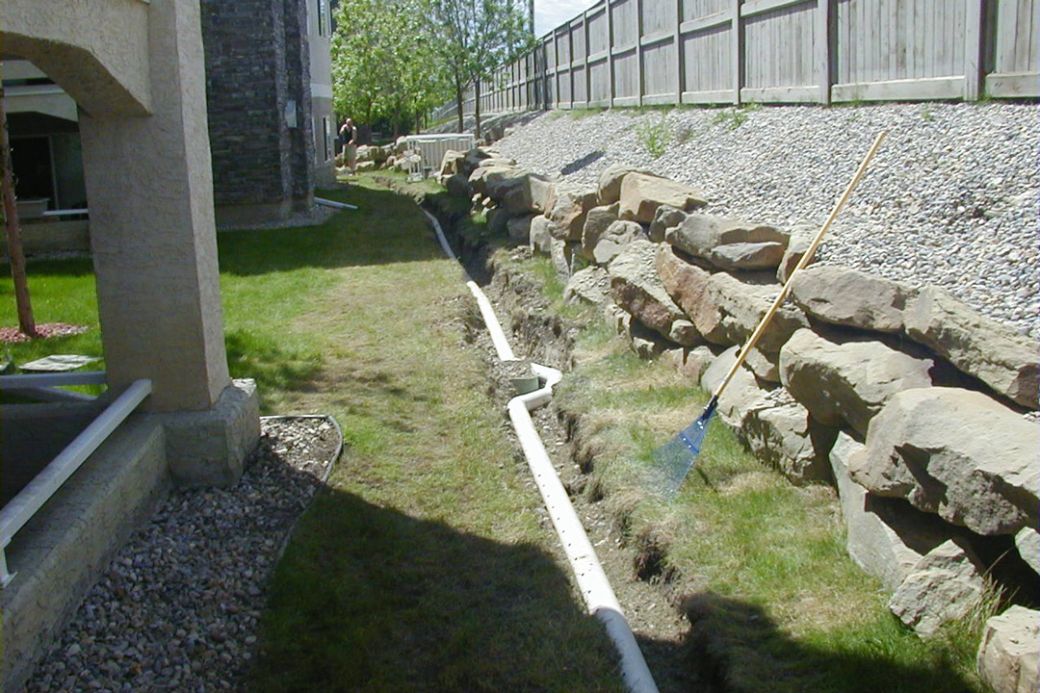A French drain, sometimes called a curtain drain, is a simple system with no moving parts. Gravity removes excess water from problem areas in your yard. You can give gravity a chance to do its job by making sure your French drain design has the proper slope from beginning to end.
Which End Is Up?
The two ends of a French drain system are:
- The drain field, or high end, where excess ground water enters the drain pipes
- The drain exit, or lowest point, where water leaves the system
A French drain needs a slope of no less than 1%. That means the system should slope at least one inch for every eight feet of length from the highest point of the drain field all the way to the drain exit.
Start With Your Exit Strategy
Select a location on your property for the drain exit. The goal is to move water away from your house and foundation, or from the soaked part of your yard, to a drier area.
Good locations for drain exits include:
- A grassy slope that’s exposed to the sun for most of the day. Grasses help absorb moisture, and the sun aids evaporation.
- A spot closest to your problem area so you can keep the system as short as possible, saving money.
- The street, so that your municipal storm drain system can carry water away. But check with your local building department first.
Don’t locate the drain exit where:
- Runoff is directed toward a neighbor’s yard.
- The water could run onto a sidewalk or driveway and turn to ice during freezing weather. Directing drainage toward pavement often violates building codes.
- Runoff could cause erosion, such as a dirt slope with no protective vegetation.
Connecting to an Existing Drain Line
Some houses have rain gutters that empty into an underground drainage system, which ties into a municipal storm drain. Your French drain can also tie into this system.
Local codes might require a backflow valve that prevents water from backing up onto your property if a clog occurs downstream. Expect to pay about $750 or more for a plumber to install this device.
No Acceptable Exit Point
If you can’t find a good place for your system to drain, you’ll need to empty your system into a dry well. That's a vertical hole, typically about four feet deep and one foot in diameter, that’s filled with gravel. A dry well lets excess water be absorbed by the surrounding soils.
Determining Proper Slope
If your yard is sloped, it may be easy to spot the high point (drain field) and low points (drain exit) for your system.
If you’re not sure, use a line level to determine slope:
- Pound a stake into the problem area and another at a possible exit point.
- Tie a mason’s string to the stakes.
- Put a line level on the string. Pull the string taut and level.
- Measure the distance from the string to the ground at the stakes, and calculate the drainage slope.
Remember, you can add some slope when you install your system by digging the trench progressively deeper.
Using a Professional to Determine Slope
A surveyor, civil engineer, or landscape contractor will use a tripod-mounted transit level to help you determine the slope you’ll need for your system and possible exit points.
Route Around Roots and Utilities
- Plan to route your drain line around large trees to avoid cutting roots. Roots usually extend to the “drip line” of the tree, which is the farthest edge of its branches.
- Call 811, the call-before-you-dig hotline, to have the location of underground utility lines marked on your property. You want to check not only in areas where the drain will live but also where you might dig a dry well. This is a free service.
Related: When You Need a French Drain
